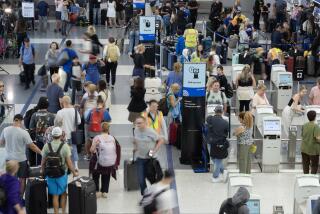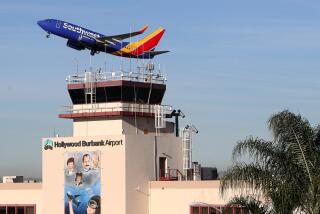With a push of this button, an airplane-noise complaint is filed
Barbara Deckert has a new weapon in the war against airplane noise, and she’s not afraid to use it.
Every time a plane flies over her suburban Maryland home, rattling her windows and setting her teeth on edge, she presses a small white button and feels a tiny sense of triumph.
That’s because with one click Deckert has done what could have taken her hours to do a few months ago: She has filed a noise complaint with officials at the Maryland Aviation Administration.
Thanks to the ingenuity of a software engineer from San Diego, Deckert and hundreds of others with similar beefs now have an easy way to register their annoyance with the jets that fly over their homes: the Airnoise button.
“It’s a fabulous tool,” Deckert said. “Clicking that button is really psychologically satisfying.”
Officials at airports from Seattle to Baltimore said Airnoise had led to a dramatic surge in complaints. At Baltimore-Washington International Thurgood Marshall Airport, officials are almost certain Airnoise is the reason complaints surged to 17,228 in August from just 2,692 the previous month. In San Diego, more than 90% of the complaints came through third-party apps such as Airnoise.
Airnoise is the brainchild of San Diego resident Chris McCann, who repurposed the same plastic Dash Button that Amazon customers use to order toilet paper and detergent. (Amazon founder Jeff Bezos owns the Washington Post.)
One click of the red-and-white button, and McCann’s software program sends a detailed complaint directly to the agency in charge.
“Airport authorities don’t make it easy to file noise complaints, but we do,” McCann’s site boasts. “With the click of a button, instantly locate loud, bothersome flights, automatically file a complaint and get back to things that matter to you.”
McCann launched Airnoise in 2017 to help fellow residents in their fight about noise from flights at San Diego International Airport, near his home in the La Jolla neighborhood. Word quickly spread. Soon other communities’ residents, who are engaged in similar skirmishes, wanted the buttons.
So far, he has sent out more than 700 of the clickers. As of mid-December, users had filed nearly 1.1 million noise complaints at 29 U.S. airports.
“People want to do something about the problem, but they have lives to live, kids to raise, and they don’t want to spend an hour or two filing noise complaints,” said McCann, who is also a former Air Force test pilot. Airnoise is a “low-impact way for people to do and say something about the issue.”
Scott Stevson, who works with the Quiet Skies Coalition near Seattle, said the two dozen buttons the group recently ordered were quickly snapped up.
Mark Anderson, who lives in Park Ridge, Ill., keeps his on his nightstand — all the better to report those late-night flights into O’Hare International Airport. Since he and his wife, Mary, got their buttons four months ago, they’ve filed roughly 5,000 complaints.
“It’s almost too easy,” he said. “But these are real complaints.”
Robyn Winder of Hanover, Md., got her button in August — and life hasn’t been the same since.
“Oh, the joy, the sheer pleasure of pushing that button and seeing the complaints mount up,” she wrote in response to a reporter’s query. “We are over 115,000 complaints for BWI, more than 35,000 in just the past 30 days! So now when MAA wants to know ‘which flight bothered you,’ I have a real answer! ALL OF THEM.”
Even before the arrival of Airnoise, airports had been dealing with a surge in complaints linked to the Federal Aviation Administration’s effort to modernize the air traffic system, known as NextGen.
The multibillion-dollar program is changing the way air traffic is managed, moving it from radar to satellite navigation. Proponents say it makes the air traffic system more efficient because it enables planes to fly more direct routes to their destinations.
But the shift has angered people who live in neighborhoods that are below the new flight paths. Residents in northwest Washington sued the FAA over the changes but lost in court. A suit filed by the state of Maryland is pending.
McCann was one of those affected. He lived in La Jolla for more than a decade and, aside from the occasional stray plane, had not had problems with noise. But that began to change in fall 2016.
As he got more involved in the issue, he realized it wasn’t easy to file a complaint with the local airport authority. Those who were able to figure out how to do so often couldn’t provide the kind of detailed information useful to officials.
He remembered reading a story about a guy who’d rigged a Dash Button to help him easily donate $5 to the American Civil Liberties Union every time he got angry at President Trump. He figured he could do something similar.
When users press the button, Airnoise uses publicly available data sources to determine which aircraft is closest to a person’s home. It gathers information about the flight and sends it to the local airport authority.
Users sign up via the Airnoise website. With a free account, they can file up to 15 complaints a month; for $5 a month, they can file unlimited complaints. The button costs $24. McCann, who has a full-time day job, says he charges just enough to cover his costs.
The button may make its users feel good, but whether it will be effective in the battle against airplane noise is unclear. Airport officials often try to downplay complaints, noting that they are the work of just a few people. Maryland airport officials, for example, were quick to note that 80% of the complaints filed in 2018 came from fewer than 100 users of the Airnoise app. McCann said he tangled with a few airports that early on tried to block reports generated by Airnoise.
Still, some airport officials say more information is always helpful.
“The bottom line for us is if you are an individual expressing a complaint about airport noise, we don’t care about how we’re getting the information,” said Mike Jeck, manager of the noise office for the Metropolitan Washington Airports Authority.
Deckert says she firmly believes complaining makes a difference, so she tries to do her part each day. When her Airnoise button arrived in August, she hooked it onto a red, white and blue lanyard so she’d have it with her all the time — in the morning when she’s making breakfast, in the afternoon while she’s puttering around the house and in the evening when she’s watching her favorite mystery shows on PBS. The button has clearly gotten a lot of use: The plastic coating is partially peeled off. A few weeks ago, the battery gave out. So for now, she’s using her iPad to file complaints.
“People can try to discredit me, but I don’t worry about that,” she said. She paused and remembered the day she filed her first complaint with the Airnoise button.
“It felt so good,” she said. “It’s highly, highly therapeutic. It makes you feel like you can make a difference.”
Aratani writes for the Washington Post.






